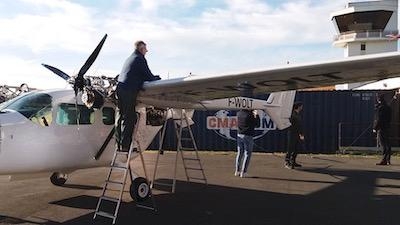Engines Will Combine To Provide Nearly 800 Horsepower
VoltAero is nearing the next phase of flight testing that will take its Cassio aircraft a major step closer to the full-up hybrid-electric configuration with a combined power of nearly 800 horsepower and top speeds of more than 200 kts.

For the upcoming phase of flight tests, VoltAero’s Cassio 1 testbed has been equipped using new-generation ENGINeUS smart electric motors from Safran Electrical & Power, along with new-design propellers. The electric motors are housed in purpose-built nacelles that have been integrated on the Cassio 1 testbed’s wings.
In the upcoming flight evaluations, the testbed aircraft will retain its original front and rear thermal engines, enabling the ENGINeUS 45 electric motors’ functionality – along with the operation of the battery modules installed in the wings – to be evaluated with complete safety. This arrangement of the Cassio 1 testbed is designated the “Version 2.2” configuration, which will be flown for approximately 20 hours.
When the Cassio 1 testbed’s Version 2.2 configuration flight tests are completed, VoltAero will remove the aircraft’s original rear thermal engine, replacing it with the other key element of the company’s hybrid electric aircraft configuration: the proprietary hybrid power module.
At this point in the development, the flying testbed’s original forward-mounted thermal engine also are to be removed, replaced by a smooth nose fairing containing additional electric batteries. The combination of two wing-mounted electric motors and the aft hybrid power module represents the propulsion configuration for the upper-end of VoltAero’s Cassio aircraft product line – which will have from four to nine seats.
The power module – which incorporates three 60-kW high-performance electric motors and an internal combustion engine capable of producing 370 hp. – is continuing its development on a ground test rig. This power module has two purposes: it serves as an electrical generator to recharge the Cassio aircraft’s batteries and drives the rear-facing “pusher” propeller.
When equipped in the full-up hybrid propulsion arrangement – comprising the two wing-mounted electric motors in the “pull” position, and the aft-facing hybrid power module with the “pusher” propeller – the Cassio 1 testbed aircraft will be flown for more than 100 hours, including endurance and demonstration flights, validating the complete propulsion system for VoltAero’s production Cassio aircraft. The “full-up” hybrid propulsion configuration will be used for the nine-seat version of VoltAero’s Cassio aircraft.
Development and flight test activity for Cassio aircraft is being performed by VoltAero at its Aérodrome de Royan-Médis headquarters in the Nouvelle-Aquitaine region of France.
Production versions of Cassio aircraft will have a flight duration of at least 3.5 hours, with an extension possible to 5 hours. The aircraft will be marketed as a general aviation platform for private owners, air taxi/charter companies, commercial flights for point-to-point regional travel, and for use in other utility-category applications.
(Image provided with VoltAero news release)
 Sierra Space Repositions Dream Chaser for First Mission
Sierra Space Repositions Dream Chaser for First Mission ANN's Daily Aero-Term (05.10.24): Takeoff Roll
ANN's Daily Aero-Term (05.10.24): Takeoff Roll Aero-News: Quote of the Day (05.10.24)
Aero-News: Quote of the Day (05.10.24) Aero-News: Quote of the Day (05.11.24)
Aero-News: Quote of the Day (05.11.24) ANN's Daily Aero-Term (05.11.24): IDENT Feature
ANN's Daily Aero-Term (05.11.24): IDENT Feature



